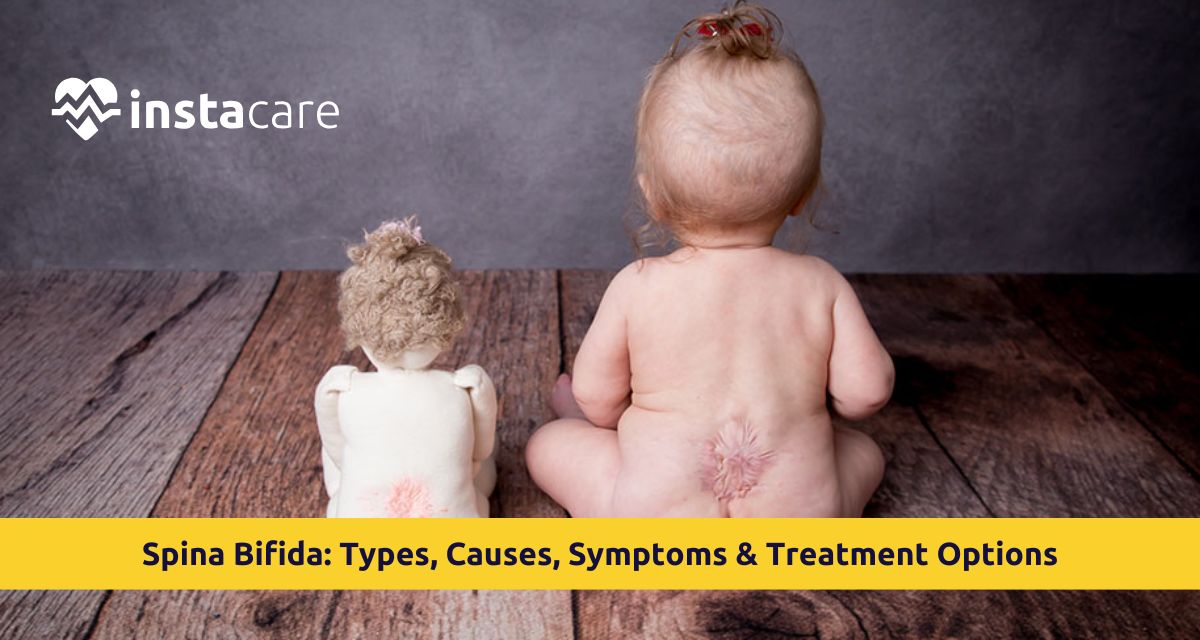What is Spina Bifida?
Spina Bifida is a type of defect at the baby’s birth. This situation occurs during the first month of pregnancy, when the neural tube of the baby doesn’t swirl and close completely to form a spinal cord. The neural tube doesn’t curl up like a zipper to form a proper spinal cord, leaving a gap at some point. This situation is called Spina Bifida.
Types of Spina Bifida
There are three types of Spina Bifida: meningocele, spina bifida occulta, and myelomeningocele.
Meningocele:
This is a type of Spina Bifida that happens when a sack of fluid occurs at the baby’s back. A sack of fluid means tissues filled with fluid appear at the back of the baby that looks similar to a pouch or bag. However, the sack of fluid does not include any part of the spinal cord. This is because there hasn’t been any nerve damage of this type. Meningocele only causes minor disabilities.
Spina Bifida Occulta
This is the minor type of Spina Bifida. It is also known as “hidden” Spina Bifida. This type of Spina Bifida does not cause any disability and might go unnoticed later in life. Occulta is a type of Spina Bifida in which there is no opening at the baby’s back at the time of birth. This type only creates a gap in the spinal cord. Also, there is no damage to the spinal cord and the nervous system in this type of Spina Bifida.
Myelomeningocele:
Myelomeningocele is the most common and severe type of Spina Bifida. In this type, a sack of fluid appears on the opening of the baby’s back, somewhere along the spinal cord. This sack of fluid carries part of the spinal cord and nerves. The nerves and spinal cord will be damaged in this sack of fluid. People who have this type of Spina Bifida have physical disabilities, such as the inability to move or feel their legs or feet, and the inability to control and release urine or feces.
Symptoms of Spina Bifida
Every type of spina bifida has different types of symptoms.
Meningocele:
The symptoms of Meningocele spina bifida include:.
- A sack or pouch of fluid that is clearly visible at the time of birth.
- A small opening at the baby’s back at the time of birth.
- Normal development of the spinal cord.
- Lining bulges through the opening in the vertebrae into the sack or pouch.
Spina Bifida Occulta:
Symptoms of spina bifida occulta are as follows.
- A gap between the spinal cord.
- No proper opening is visible on the outside of the baby’s back.
- No sack or pouch filled with fluid outside of the baby’s back.
- Small birthmark on the back.
- Dimple on the back of the baby.
- A small cluster of hair on the baby’s back.
- An area of extra fat on the back
Occulta is such a minor type of spina bifida that a person might not know that they have spina bifida.
Myelomeningocele:
Symptoms of Myelomeningocele spina bifida include:
- Issues with the bladder and intestines
- Seizures
- Week leg muscles
- Curved spine
- Hips that are not even
- The spinal cord extruded outside is clearly visible under the skin.
- Deformed feet
- Open spinal canal over some vertebrae, usually in the middle or lower part of the back.
Causes and Risk factor of Spina Bifida
There is no proper research found on the exact cause of spina bifida. However, there might be genetic or environmental factors. There is a chance that a baby born with spina bifida does not have any close relatives born with this disease, although genetics plays an important role in the development of a baby.
Some believe that a deficiency of folic acid, also known as Vitamin B-9, might be the main reason for spina bifida. Other factors may include parents, especially mothers, on some medication before or during pregnancy, excessive fat on the parents' bodies, or diabetes in the mother.
Treatment of Spina Bifida:
There is a different treatment for each type of spina bifida. The treatment also differs from person to person. Occulta is a minor type of spina bifida, and in this type there no treatment is required. In case of the other two types of spina bifida, a proper surgery is required to place the visible sack of fluid and nerves back in their place. Sometimes, removal of a sack filled with fluid is also required.
The surgery needs to be done shortly after the baby’s birth to limit the damage done by spina bifida. In some severe cases, even surgery is required before the baby’s birth. Occasionally, after the surgery is done, there might be some symptoms and remnants of spina bifida.
Paralysis and bladder issues remain throughout life, mostly.
Living With Spina Bifida
Living with Spina Bifida is a personal choice, as it requires lots of lifestyle changes and personal care. The impact of spina bifida varies from one type to another. If a person chooses to live with spina bifida, then they have to deal with the mobility issue and bladder problem.
Conclusion
Spina Bifida is a type of disease that occurs at the type of birth and it can be managed with proper treatment and care. If any person has spina bifida, then they should consult a doctor immediately, and if surgery is required, then it should be done to limit the damage to the nervous system.
Please book an appointment with the
best Neurologist in Lahore, Karachi, Islamabad, and all major cities of Pakistan through
InstaCare, or call our helpline at 03171777509 to find the verified doctor for your disease.

